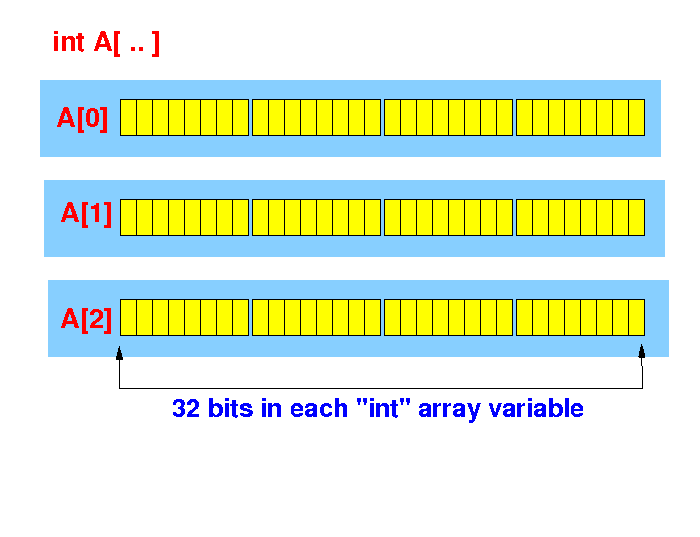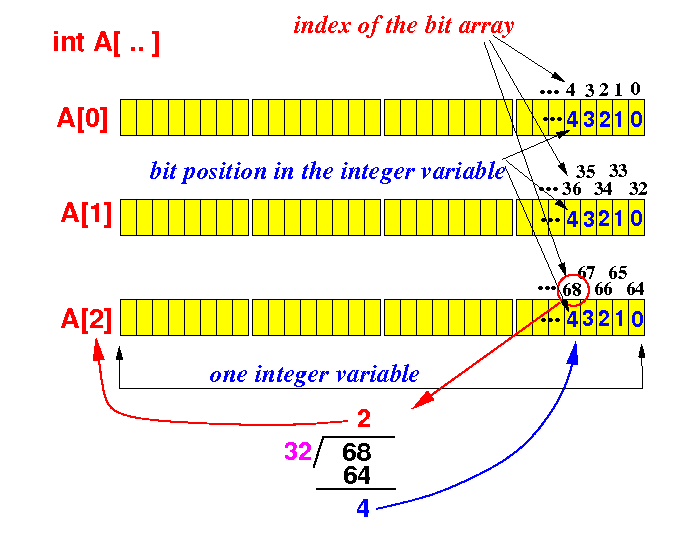The usage of
an array of
bits
- C
(and Java)
provides the
programmer with
arrays
of the basic data types,
such as:
char a[10]; // Each array element is 1 byte
short b[10]; // Each array element is 2 bytes
int c[10]; // Each array element is 4 bytes
|
- The C programming language
does not provide
array of
bits
- Why use
an array of
bits ?
- A bit can store
one of the
values
0 or
1
- A bit array is
ideal to
store a
series of
boolean variables
|
- I.e.:
- We can use an
array of
bits as
an
array of
boolean variables !
|
|
The
bit array data structure and
its
operations
- An array of
bits
A is an
array variable where:
A[k] = 0 or 1
I.e.: Each element can only take on
(1) the value 0 or
(2) the value 1
|
- Operations on
a bit array
A:
Operation Effect
================================
SetBit(A, k) A[k] = 1
ClrBit(A, k) A[k] = 0
IsSet(A, k) (A[k] != 0)
|
|
We will next
implement
the bit array
data structure using
an
array of
int variable
How to implement a
bit array using
an int array
- Suppose we
have an array
of int A[ ]:

- Each
array element
A[k] is
an
int typed
variable and
contains
32 bits
|
How to implement a
bit array using
an int array
- The
bits in
each
array element
A[k] is
numbered
as follows:

- We will
map the
bits in
the bit array onto
the bits in the
int
|
How to implement a
bit array using
an int array
- The
first
32 elements (= bits)
in
the
bit array is
mapped to
A[0] as
follows:

- We wil
use
A[1] to
map the
next
32 elements (= bits) of the
bit array !
|
How to implement a
bit array using
an int array
- The
second
32 elements (= bits) in
the
bit array is
mapped to
A[1] as
follows:

- We wil
use
A[2] to
map the
next
32 elements (= bits) of the
bit array !
|
How to implement a
bit array using
an int array
- The
third
32 elements (= bits)
in
the
bit array is
mapped to
A[2] as
follows:

-
And so on...
|
How to implement a
bit array using
an int array
- The array elements of the
bit array are
mapped to
the array elements of the
int array A
a follows:

-
Question:
how to
map
a bit array index
k to
(1)
an array element A[i] and
(2) the
bit position within that
array element
|
How to implement a
bit array using
an int array
- Suppose we want to
map the
bit array element with
index = 68:

- How to find
the array element and
the bit position
corresponding to
this bit array element?
|
How to implement a
bit array using
an int array
- Because an
int variable has
32 bits,
we divide the
bit array index by
32:

- Compute the
quotient and
the remainder !
|
How to implement a
bit array using
an int array
- We can see that:
(1) the
quotient =
index of the
int array element
and
(2) the
remainder =
bit position within the
int array element:

-
Mapping:
bit array element
with index
k --->
A[k/32] and
bit position
k%32
|
Implementations of
SetBit(A, k)
- The
SetBit(int A[ ], int k)
function:
(step-by-step)
void SetBit(int A[ ], int k)
{
int i = k/32; // Map bit array index --> int array index
int pos = k%32; // Map bit array index --> bit position
int pattern = (1 << pos); // 000..00100..000
A[i] = A[i] | pattern; // Set bit at position pos to 1
}
|
- You can write
SetBit(int A[ ], int k)
much shorter:
void SetBit(int A[ ], int k)
{
A[k/32] = A[k/32] | (1<<(k%32));
}
|
- Or as a macro:
#define SetBit(A,k) ( A[k/32] |= (1<<(k%32)) )
|
|
Implementations of
ClrBit(A, k)
- The
ClrBit(int A[ ], int k)
function:
(step-by-step)
void ClrBit(int A[ ], int k)
{
int i = k/32;
int pos = k%32;
int pattern = ~(1 << pos); // 111..11011..111
A[i] = A[i] & pattern; // Clear bit at position pos to 0
}
|
- You can write
ClrBit(int A[ ], int k)
much shorter:
void ClrBit(int A[ ], int k)
{
A[k/32] = A[k/32] & ~(1<<(k%32));
}
|
- Or as a macro:
#define ClrBit(A,k) ( A[k/32] &= ~(1<<(k%32)) )
|
|
Implementations of
IsSet(A, k)
- The
IsSet(int A[ ], int k)
function:
(step-by-step)
int IsSet(int A[ ], int k)
{
int i = k/32;
int pos = k%32;
int pattern = (1 << pos); // 000..00100..000
return (A[i] & pattern) != 0; // Test bit at position pos
}
|
- You can write
IsSet(int A[ ], int k)
much shorter:
int IsSet(int A[ ], int k)
{
return ( A[k/32] & (1<<(k%32)) ) != 0;
}
|
- Or as a macro:
#define IsSet(A,k) ( ( A[k/32] & (1<<(k%32)) ) != 0 )
|
|
DEMO:
demo/C/set1/bit-array1.c
❮
❯








